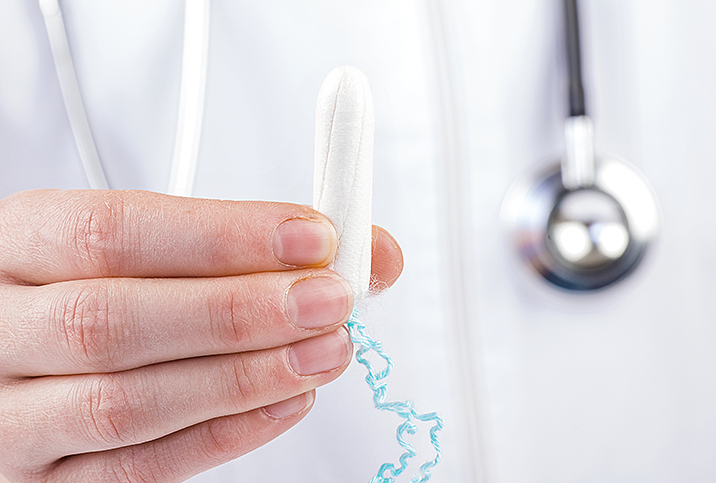How to Use a Tampon When You Have Vaginismus

A couple of months ago, I walked into the bathroom feeling determined. I wasn't going to wear a diaper (read: pad) during my time of the month anymore. To get hyped up and relieve some of my anxiety, I pressed play on "7 rings" by Ariana Grande, focusing on the lyrics, "I want it, I got it."
For years, I've found using tampons is basically impossible because I have vaginismus, a condition where the vagina involuntarily contracts during penetration. As I listened to the music and angled the tampon, I felt silly—and uncomfortable. I knew, deep down, no period product is more or less feminine than another, but I ached for the femininity I associated with tampons.
I'd tried many approaches before, ranging from the slightly embarrassing to the possibly smart: asking my girlfriend to put the tampon inside me, putting lube on it, standing in different positions, awkwardly angling a mirror between my legs, and waiting until my flow was heavier. Nothing worked completely, which was admittedly maybe too much to ask for, especially at the beginning. Either the tampon didn't go in or didn't go in correctly, or the pain and anxiety from past sexual trauma made me hyperventilate and want the tampon out ASAP.
I'm not alone in this struggle. Most people with vaginismus aren't able to insert a tampon, according to a study published in the Journal of Sexual Medicine, and the inability to insert a tampon can be noted at a young age.
'We are living in a material world...'
Let's talk materials, specifically, the one used to make your tampon. Believe it or not, organic cotton tampons may be the way to go.
"Many conventional tampons on the market are made out of plastics and synthetic fibers, which can irritate the vagina and can cause more painful insertion as they can feel more stiff," explained Gunvor Ekman-Ordeberg, M.D., an OB-GYN and the co-founder of DeoDoc Swedish Intimate Skin Care in Stockholm.
She believes organic tampons are the safest, cleanest and gentlest on the vagina.
Self-love your way through, in more ways than one
Remember, what works for someone else may not work for you. While that may feel frustrating or upsetting, it doesn't mean something is wrong with you. Remind yourself that vaginismus isn't your fault, and it doesn't make you less than anyone else. Your well-being is important—more important than using a tampon.
"It is important to remember that you do not need to pressure yourself into making it work if it is still very painful," Ekman-Ordeberg said.
As you repeat those affirmations, remember to breathe.
"Deep breathing can help focus relaxation on the pelvic floor muscles," said Anna Cabeca, D.O., a triple-board-certified OB-GYN in Texas and the author of "MenuPause," an upcoming book on diet and menopause.
Another way to work on those muscles on your own is low-key, vaginal masturbation.
"Prior to using the tampon, gently insert one finger in the vagina and put pressure at 5 o'clock and 7 o'clock, assuming the clitoris is 12 o'clock," Cabeca said. "[Hold] pressure until you feel those muscles relax and then insert the tampon. Additionally, the use of smaller to larger vibrators can help."
Hit up your doctor
As with any medical concern, professional support is a great idea. Ekman-Ordeberg recommended getting tips from your doctor that are specifically tailored to your vaginismus, and Cabeca encouraged pelvic floor therapy.
"I cannot emphasize how important it is to get to the underlying issues, because the piriformis muscle also can contribute to vaginismus in having spasms," Cabeca said.
Sure, many period products are more sustainable and easier to use than tampons. But if you want to use a tampon, I hear you. You may still experience some pain and discomfort—especially at first—but these steps can help. If they don't, and the pain is too much? Using a pad or other product is perfectly OK, too. I'm reminding us both of that.


















